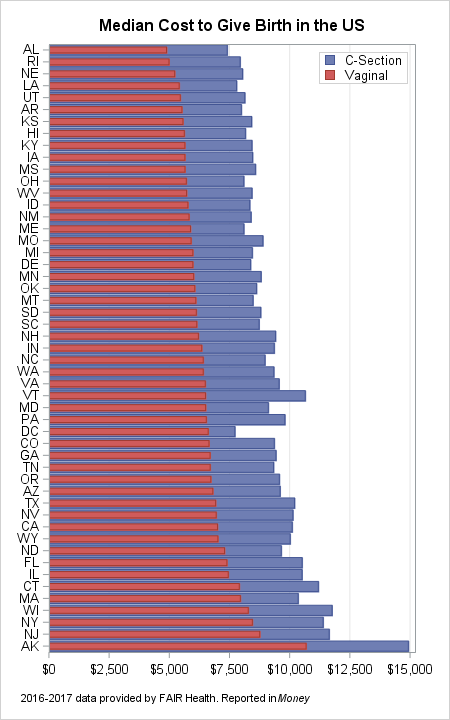Money magazine (Jan/Feb 2018) contains an article about how much it costs to give birth in the US. The costs, which are based on insurance data, include prenatal care and hospital delivery but exclude infant care. The data are compiled for each state (including Washington, DC) and by type of delivery (vaginal versus cesarean section). The data includes the average and median costs for each state.
The online version of the article contains a map and a table of average costs, colored by the quintiles of the costs. Because I think that median costs are more relevant, I decided to create a visualization of the distribution of the median costs. Additionally, I want to visualize the incremental cost of a C-section over a vaginal delivery. According to the CDC, about 32% of deliveries are C-sections in the US. Cesarean delivery is major surgery and often requires an additional two days of hospital recovery in addition to operating-room charges.
With a little sleuthing, I was able to locate the data and download it into a SAS data set. You can download the data and SAS program that creates the graphs in this article.
Cost Distribution and incremental cost of a cesarean delivery

The adjacent bar chart (click to enlarge) shows the distribution of the median costs of childbirth in the US. Since the median cost of a cesarian delivery is always more than the median cost of a vaginal delivery, I overlaid the two graphs. (I made the bars in the foreground slightly thinner so that the graph does not look like a stacked bar chart.) The states are ordered by the median cost of a vaginal delivery. The data shows that the states of Alabama, Rhode Island, Nebraska, Louisiana, and Utah are the least expensive states for vaginal delivery. The median cost is about $5000 in those states. The most expensive states include Alaska, New Jersey, New York, Wisconsin, and Massachusetts. The median cost is more than $8000 for those states, with Alaska topping out at $14,500.
If you are more interested in the cost of a cesarean delivery, I created a similar graph sorted by the cost of a C-section. No matter how you sort it, the graph indicates that a C-section costs about $2500 to $3500 more than a vaginal delivery. In Washington, DC, the incremental cost is about $1100, which is relatively low. In Vermont and Alaska, the incremental cost is more than $4000, which is relatively high.
The Money magazine map of the data does not reveal any unexpected regional trends. Costs are high in Alaska and New England. Costs are low in some southern states.
Comparing delivery types by using a scatter plot
For a more sophisticated audience, you can use a scatter plot to plot the costs for vaginal and cesarean delivery in each state. A plot of the median costs is shown below. A regression line to these data has a slope of 1.2, which indicates that, on average, the median cost of a C-section is about 20% more than for a vaginal delivery. This visualization also enables you to see that Alaska is an extreme outlier for both types of delivery.

The Money article about these data points out two facts that cannot be seen in the data. First, it says that women "who have no insurance... are usually charged a higher amount than the negotiated rate." Second, US women "pay more to have a baby than residents of any other country. The highest prices in the U.S. were more than double those of the second-most expensive country, Switzerland" (emphasis added)." For a comparison of different countries, see Parents magazine (Jan 2017).
What interesting facts do you notice about these data? Leave a comment.

1 Comment
We are lucky in our family that -- thanks to my employer -- we have good health care coverage. The birth procedure for each of our three daughters cost us very little out-of-pocket. (That's in terms of money -- my wife certainly endured short-term discomfort that you can't express in dollars.) However, we still receive a hospital bill that shows the fees as billed to the insurance company. We've kept each of these and included them in the girls' "baby books" as proof-of-receipts in case we ever wanted to return them. (Never considered going through on that threat...)
That initial cost is just the beginning. Bringing children into the world is relatively inexpensive compared to the longer term cost of raising them to independence. It's an investment -- worth every cent.